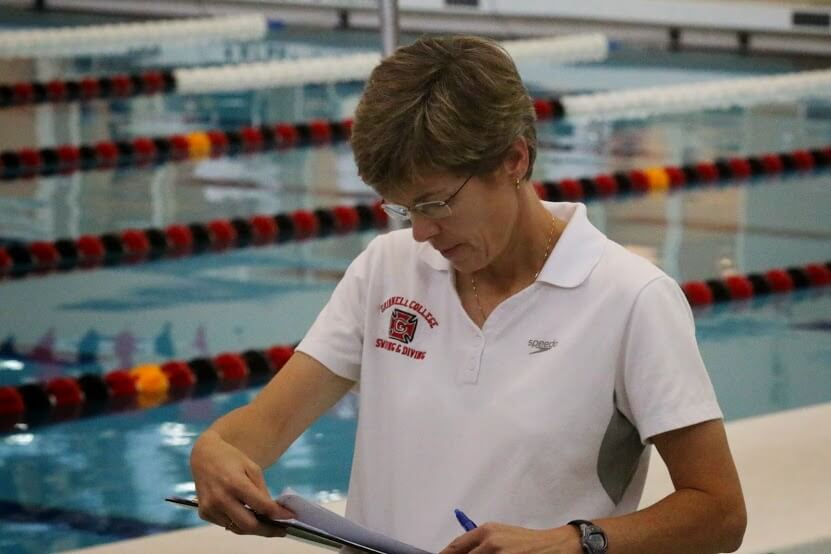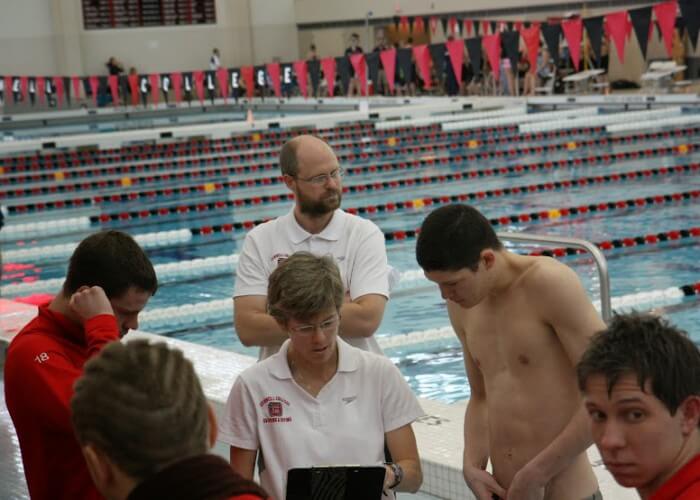Coaching Swimming From A Division III Perspective

By Connor Bailey, Swimming World College Intern
Coaches are the glue of the swimming community. Though swimmers shine and fade with their athletic careers, a coach has a more permanent presence. Their experience with the sport lends them a wizened perspective. But, when we talk to coaches, it’s only about their swimmers. We ask how are Suzy Q and Benny A doing this season? Or, a perennial favorite, What do you think about your prospects for the championship? Too often, the time-honed insights of these individuals go unheard.
Unsung D3 Heroes
For college swimming, only a small portion of the total coaches, those at the NCAA Division I schools, receive much attention. These are the biggest, most elaborate, and most competitive programs — but they are not the only programs. Descending two levels of obscurity, coaching swimming on the Division III level often go almost completely unnoticed even though their perspectives, from the grassroots of the college swimming community, have welcoming nuance and clarity.
Two of these coaches, Erin Hurley and Tim Hammond, are respectively the head coach and assistant coach of Grinnell College’s swim team. Grinnell, a small liberal arts school in Iowa, competes in the Division III Midwest Conference (MWC).
Neither had intended to coach professionally.
“It was not planned as a career choice,” Tim Hammond puts it bluntly. “I felt like I knew more about this than anything else.”
Like almost all coaches, Tim began as a swimmer and continued his athletics through his academic career at another small liberal arts school, Luther College. In high school Hammond had coached his city recreation team, then at his graduation from Luther, he was asked to join the coaching staff of his alma mater. From there, he arrived at Grinnell College, where he has spent the better part of a decade.
For Hammond, his experience with coaching and in the environment of a D-III college made Grinnell seem like an obvious choice. Hurley’s story is a bit different.
It wasn’t until Erin Hurley was finishing her swimming career as a Division I swimmer for University of Nebraska that she began to consider coaching. After her NCAA eligibility, Hurley stayed at Nebraska to take some more classes and was offered the opportunity to rejoin her team as a volunteer assistant coach.
“I wanted to stay engaged,” she said. “I was just finishing my career, of something that I had dedicated all but four years of my life to.” After graduating from Nebraska, Hurley was still unsure of the path ahead of her.
“I had no idea what I wanted to do, but I really enjoyed my one year of coaching.” That experience would propel her to get her masters in Sports Psychology from the University of Iowa. As part of her program she was given the opportunity to help coach the women’s team. After receiving her Masters, Hurley spent one year coaching at Cornell College in Iowa, and two years at Illinois Wesleyan.
Then, in her words, “The Grinnell position opened up, and here I am twenty years later.”
Though Hurley says she never sought to coach at a Division III-school, she certainly didn’t dislike the prospect.
“I’m going to be able to do some teaching and I’m going to be able to do coaching as well, and it’s a small school and I’d never had that experience,” Hurley said. She thought about returning to D-I once, and even interviewed for a position, but wasn’t offered the job.
“I thought ‘maybe that’s telling me something,’” Hurley said. She has not looked back since.
The D3 Distinction
The difference between a D-I and D-III programs is not inconsequential.
“Small schools want to provide the same opportunities that big school do,” Hammond said. The only problem is resources. “I get to, sometimes I have to, but a lot of times I get to do other things, because its needed, and because the opportunity is there.” Hammond says that the necessities of coaching at this level “allow me to be more than just a swimming coach on the deck.”
But sometimes he needs to be just the one thing.
“At certain times winning is on the forefront of my mind, but the background or the base of what I’m doing here at Grinnell College isn’t necessarily winning,” Hammond said. “It’s about providing opportunity for students to participate in something that they love.”
Hammond sees his job to convert that love into success, both inside and outside of the pool. Hurley affirms this idea and in describing her job says simply (but ecstatically), “It’s being a mentor.”
Though she says she never made a conscious decision to leave D-I, in her time as an athlete and coach, she noticed some things that troubled her.
“I was aware of the lack of balance that some of them had in their heads,” Hurley said. “You know, swimming was everything, and it was the most important thing in their life…and that was me too.”
Only One Dot in the Circle
Hurley tries to get beyond the “tunnel vision” of Division-I, describing her view as “more of a holistic perspective.”
Juxtaposing the obsession of her youth, Hurley says that being a good Division III coach means realizing “[For the swimmers] This is one point in time, and a very important one or a somewhat important one, or kind of important one…and all of that’s okay.”
As coaches, they are very intentional about creating an atmosphere that emphasizes a broadened vision.
“Through the social structure that we try and cultivate, we’re helping people learn about themselves, and learn who they want to be,” Hammond said.
“In your big circle of who you are, one of those dots is a swimmer,” Hurley says. “It’s only one dot.” From that perspective, she says the job of a coach is to answer the question: “so how can we connect all of those dots?”
That the athletic drive to improve needs to be reflected in the coaches, according to Hammond.
“I need to be open to constructive criticism, I have to seek myself to be critical of myself and critical of what I’m doing.” A coach must be dedicated to their craft and must push themselves toward growth and be constantly learn.
“[It’s] not just physics, not just hydrodynamics; it’s understanding sociology and all these factors that play into success in the sport and helping people become good people,” Hammond said.
But coaches are still only human.
“Nobody has that the one idea that’s the top-secret thing,” she assured. “We all have methods, concepts, philosophies to share and I think we can all benefit from those conversations.”
Hopefully, this conversation was just a start.





great article- so happy my son is pursuing Division 111 swimming!
Erin is the best !
It’s an honor and a privilege to coach in the same conference as Erin and Tim. Plus it’s great to be able to compete in their wonderful pool a couple of times a year.
Great program and great coaches. Erin’s program is what being a STUDENT-athlete is all about. I had the pleasure of coaching her during the summer at Nebraska. You couldn’t sent your kids to a better person.